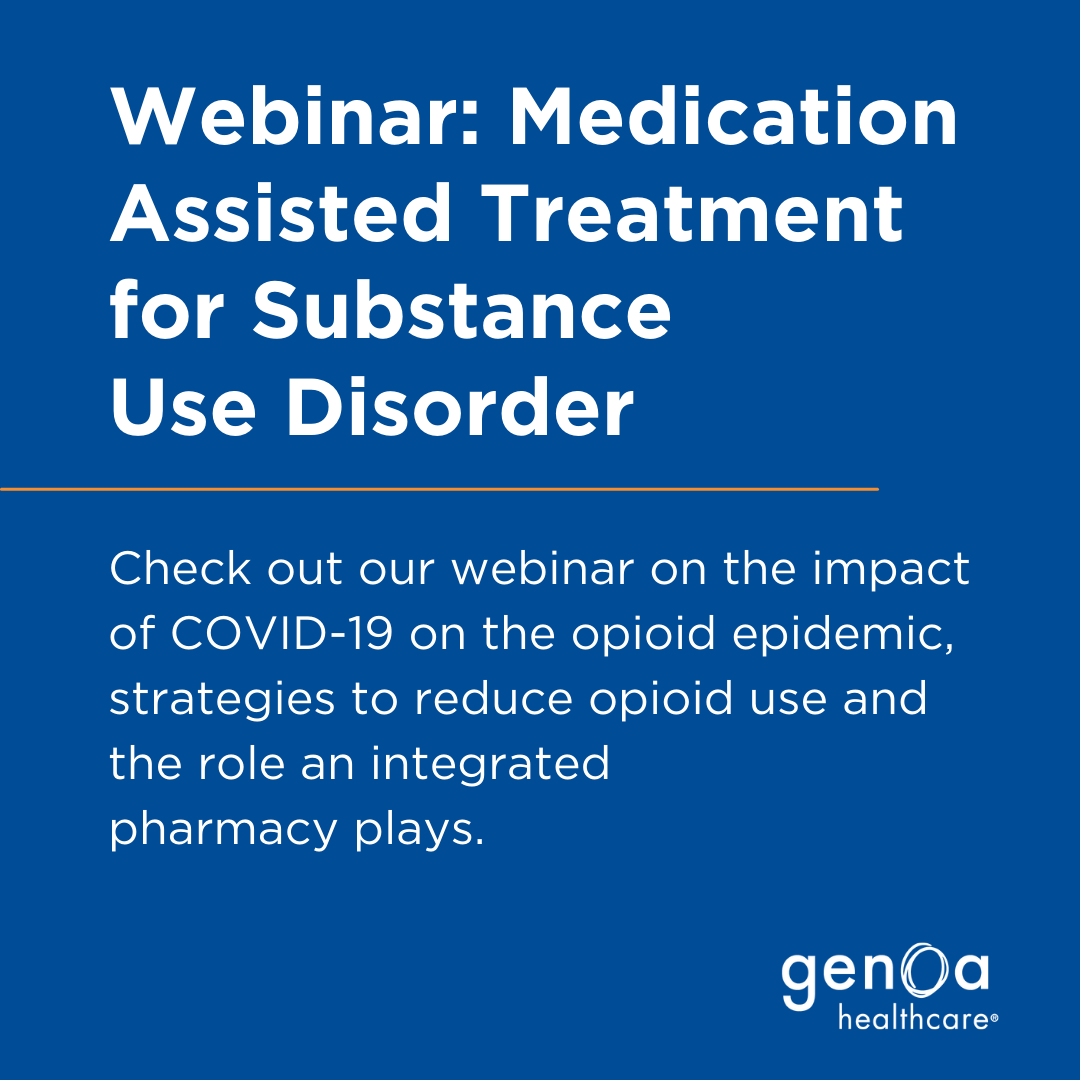A Rise in Drug Overdoses
Deaths from drug overdoses, which have climbed steadily over the past 20 years, rose sharply during the COVID-19 pandemic. This “epidemic within the pandemic” underscored the need for a more proactive approach to treating substance use disorder. Medication-assisted treatment (MAT) combined with compassionate, stigma-free care is an approach that can make a difference, according to a recent webinar hosted by Genoa Healthcare.
Genoa Healthcare’s Kevin O’Connell, RPh, vice president of sales, and Lindsey Hall, PharmD, senior director of clinical programs, were joined by Percy Menzies, president for Assisted Recovery Centers of America in St. Louis to discuss the causes of addiction, treatment options to reduce opioid use and the role of integrated pharmacy in MAT.
Watch the webinar here:
To learn more about how pharmacy services can help you and your consumers, contact us today.
Webinar Q&A
Can you talk more about the extended release forms of buprenorphine?
- Buprenorphine is a partial mu-opioid agonist. It is available in daily transmucosal (e.g. buccal, sublingual) forms, long-acting implant (i.e. Probuphine) and as an extended-release injection. Extended-release injections of buprenorphine are currently available in monthly injections with the product Sublocade. Only healthcare providers should prepare and administer Sublocade. Initiation of Sublocade treatment should occur only after induction and dose-adjustment with a transmucosal buprenorphine containing product. A once-weekly injectable preparation of buprenorphine, studied as CAM2038 (also known as Brixadi), was found to be noninferior to daily, sublingual buprenorphine. Further information on Sublocade can be found at sublocade.com. Further information on Brixadi can be found on braeburnrx.com.
What MAT options are available for minors?
- There is a recognized need to improve adolescents’ access to medications for the treatment of opioid use disorder. Of the three therapies for OUD (methadone, buprenorphine and naltrexone), buprenorphine is the only modality with an adolescent indication. It is approved for adolescents age 16 years and older. There is substantial debate regarding the use of medications for maintenance treatment of opioid use disorders in adolescents.1,2,3 Some researchers argue that there is enough preliminary evidence for all three medications to warrant consideration in adolescents. Others argue that the adolescent population has unique and complex risk factors that demand special precaution for these therapies.
- Camenga DR, Colon-Rivera HA, Muvvala SB. Medications for Maintenance Treatment of Opioid Use Disorder in Adolescents: A Narrative Review and Assessment of Clinical Benefits and Potential Risks. J Stud Alcohol Drugs. 2019 Jul;80(4):393-402. PMID: 31495374.
- Gonzales-Castaneda R, Mooney LJ, Rawson RA. Medications for Maintenance Treatment of Opioid Use Disorder in Adolescents: A Narrative Review and Assessment of Clinical Benefits and Potential Risks, Offering a Public Health Perspective-A Commentary on Camenga et al. J Stud Alcohol Drugs. 2019 Jul;80(4):403-405. doi: 10.15288/jsad.2019.80.403. PMID: 31495375; PMCID: PMC6739646.
- Vest N, Humphreys KN. Do We Know Enough to Prescribe Opioid-Agonist Therapies to Adolescents With Problematic Opioid Use? A Commentary on Camenga et al. (2019). J Stud Alcohol Drugs. 2019 Jul;80(4):406-407. doi: 10.15288/jsad.2019.80.406. PMID: 31495376; PMCID: PMC6739645.
What, if any, medications have been developed to address cocaine/crack addictions?
- Cocaine use disorder (CUD) remains a substantial public health problem. There are a number of effective behavioral interventions, including contingency management, cognitive-behavioral therapy and the use of therapeutic communities. Despite substantial work in this area, there are still no FDA-approved drugs for the treatment of CUD. Many treatments have shown signals of efficacy in early studies, but these results were not consistently produced. Treatments investigated thus far include dopamine agonists (e.g. dextroamphetamine, modafinil), antagonist strategies (e.g. antipsychotics, cocaine vaccine), GABA modulators (e.g. baclofen), anticonvulsants (e.g. topiramate) and several other mono- and combination therapy approaches. A recent review article in the journal Addiction highlight reasons why current research has not led to any promising medication-based treatments.1 These authors argue that, in addition to seeking new medications with novel modes of action, we should also re-evaluate existing literature and further explore currently available medications that were previously studied.
- Brandt L, Chao T, Comer SD, Levin FR. Pharmacotherapeutic strategies for treating cocaine use disorder-what do we have to offer? Addiction. 2021 Apr;116(4):694-710. doi: 10.1111/add.15242. Epub 2020 Sep 28. PMID: 32888245; PMCID: PMC7930140.
How does medical marijuana impact these MAT treatments?
- A 2020 systematic review of the literature did not find definitive evidence on the impact of cannabis on MAT.1 There are conflicting hypotheses that cannabis may be beneficial or detrimental to treatment outcomes. Few of the 41 reviewed studies were designed to show the independent effect of cannabis, which is a limitation to the evidence. Most of the studies demonstrated a non-significant effect of cannabis on outcomes of interest. Some studies showed a worsening of outcomes for groups using cannabis. One explanation for this may be that patients who are receiving a sub-therapeutic dose of their opioid use disorder medication may self-medicate with cannabis. Other studies showed an improvement of outcomes in cannabis-using groups. Some researchers argue that cannabinoids and terpenoids in cannabis have pharmacological properties that may affect cravings and withdrawals. In general, there is a current lack of experimental evidence to clearly explain the relationship between cannabis and MAT. Nevertheless, the authors of this systematic review conclude that cannabis use is unlikely to independently threaten treatment outcomes.
- Lake S, St Pierre M. The relationship between cannabis use and patient outcomes in medication-based treatment of opioid use disorder: A systematic review. Clin Psychol Rev. 2020 Dec;82:101939. doi: 10.1016/j.cpr.2020.101939. Epub 2020 Oct 24. PMID: 33130527.





